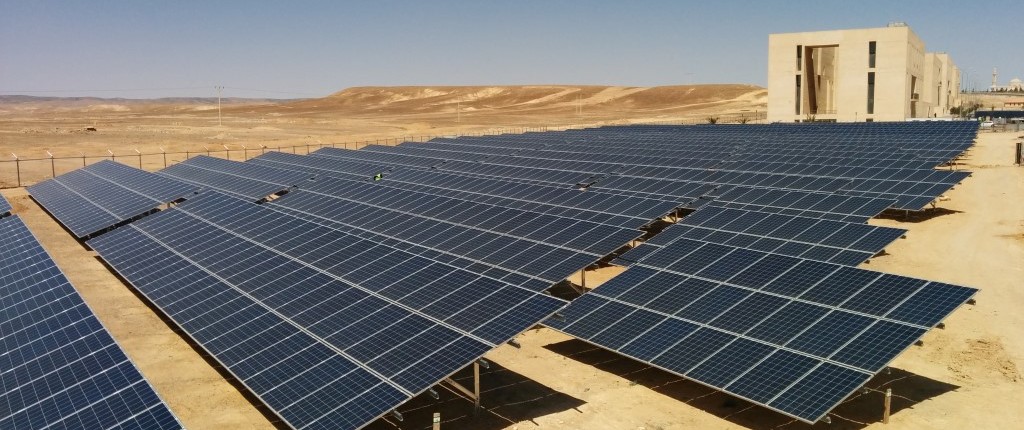This article was originally published in Building Review Journal Vol 29 No.4 , Mar/April 2014 issue.
Christophe Inglin is co-founder and Managing Director of Phoenix Solar Pte Ltd. Before co-founding the company, he was the Managing Director of Shell Solar Pte Ltd from 1996 to 2006, where he worked extensively throughout the Asia-Pacific region and was instrumental in implementing grid-connected solar electricity projects in Thailand, Malaysia, China, Hong Kong and Singapore, as well as off-grid systems in China, Indonesia and Thailand. He chairs the Renewable Energy Committee at the Sustainable Energy Association of Singapore (SEAS). Widely recognised as a photovoltaics industry expert in the Asia Pacific region, he has spoken at numerous renewable energy forums and seminars.
Ground mounted solar panels
PV Technology is great – what is there not to love about zero-carbon emissions? But you need to know if it is worth the capital investment, or what works for your building. Read on, as veteran of the Solar Photovoltaics (PV) industry, Mr. Christophe Inglin, answers some of your most burning questions.
Q: Why would developers need to implement PV system to their buildings? Would it be worth the capital investment?
From an environmental and technical point of view, solar photovoltaic (PV) technology is a clean and scalable source of energy well suited to urban areas in most of the world. From an economic point of view the viability of installing PV depends primarily on sunshine levels, installation costs and prevailing electricity tariffs. In many cases, subsidies and other interventionist policies also play a role.
In Singapore PV is already commercially viable without any government subsidies. Building owners can monetise their roof space by installing PV systems that pay for themselves within 6 to 10 years. Thailand, Malaysia and the Philippines offer specific PV support schemes in the form of Feed in Tariffs (FiT), net metering or tax exemptions, making PV an even more attractive investment.
Q: What is the regional trend in adoption of PV technology and in what direction would these trends change in the next few years?
In recent years PV system costs have declined dramatically, to the point where it is either commercially viable without subsidies, or the cost of subsidies is affordable for South East Asian governments. This has resulted in policies to encourage investment in PV, leading to the widespread adoption of scalable rooftop applications and solar farms in countries such as Singapore, Thailand, Malaysia, Indonesia and the Philippines. Mini grid grids with PV-diesel hybrid systems enable cost-effective electrification of remote regions in countries such as the Philippines or Indonesia.
As for future trends, solar PV growth is hard to predict. But we know that electricity demand will continue to increase in SEA, as will the financial burden of importing energy. Environmental pressures will also call for convincing action to reduce CO2 emissions, which will increase the value of renewable energy sources such as PV.
One consequence of clear commercial viability for PV investors is the boost it gives to installation rates. In Singapore for example, we are now seeing exponential growth with cumulative installations doubling each year. Even assuming a more conservative compound annual growth rate (CAGR) of 1.5, the country will see over 2GWp installed by 2025, which will generate close to 5% of projected electricity demand by that time.
An interesting trend is the rise of PV Power Purchase Agreements (PPAs), or leasing schemes, under which a third party finances the construction and maintenance of the PV system. This allows building owners to save money on their electricity bills from day one, with no up-front investment.
Q: What kind of systems do you recommend for different types of buildings (commercial, residential, industrial etc.)?
Every rooftop installation on a building is a custom solution because roofs vary in size, shape and construction. You must also consider the building’s surroundings to avoid or reduce shade falling on the PV modules and reducing their output.
As PV installers we need to anticipate as much as possible our client demands, developing solutions for any type of roof (metal, tiled or flat concrete roof) ensuring the optimum use of available space and minimising any shade impact.
Q: Different PV cell technologies and modules are now available. Which is the best?
That is a bit like asking what is the best type of car to buy – the answer of course depends on individual circumstances. When investing in a solar farm, space is less of a constraint and the main driving factor is the lowest installed cost per Watt, adjusted by energy output per Watt. The actual technology is less important than plant reliability; investors need to generate energy for 20-25 years to earn a decent return. Banks that finance such projects look very carefully at the credibility of the manufacturers behind the PV modules, inverters and other key components, as well as the reputation of the turnkey contractor.
On buildings, roof space is usually the key constraint, so more efficient crystalline silicon technology has an advantage over thin film technologies, because it generates more electricity per square metre of roof. But also for rooftops, module quality and reliability can be more important than the specific technology.
Q: Are there any major advances in technology on the horizon?
Despite its high-tech reputation, the PV industry is actually very conservative and treats announcements of new technology with justifiable suspicion. Unlike cell phones for example, PV systems are expected to work for two to three decades, with very little maintenance. Reliability and durability are therefore critically important, outweighing minor improvements in functionality or aesthetics. So every innovation must prove itself in the test lab and in the field before the industry embraces it. This tempers the rate of innovation.
One trend we are seeing is in module-level energy conditioning, where each module has its own power optimiser or micro-inverter. These devices can improve system yield, particularly in shade-challenged urban environments. They also offer much finer level of diagnostics and even improved safety by isolating each individual PV module in case of a fire. But the increased complexity adds cost and many more potential points of failure. Consider that module-level electronic devices are relentlessly exposed to daily temperature cycles that can range from -30°C to +85°C, but must still work reliably for 25 years. Over time, we expect mass production and fully integrated production will drive costs down as well as improve the reliability of “smart” modules.
Storage technology is a natural complement to intermittent energy sources like PV, which can destabilise the grid as clouds pass across the sun. As storage costs come down, we can include them in grid-connected PV systems to buffer the variable output. As usual, we need mass production to drive down costs of storage technology, and an obvious candidate for this is the rising demand for electric vehicles.
We are also seeing advances in smart grid technology to help manage the interplay between distributed intermittent generators (eg widespread rooftop PV systems) and electricity consumption. Sensor networks can predict PV generation at each node in the grid, while price signals can encourage non-critical loads to switch off when required to balance supply and demand.
In terms of applications, we can take PV beyond buildings and open fields. With floating PV, arrays of solar panels are supported on interlocking UV-resistant rafts and feed electricity to the public grid. Phoenix Solar pioneered the installation of the first floating PV system in SEA in 2013, a 5kW pilot project in Singapore. Floating PV is highly suited for land scarce countries such as Singapore, Philippines or Japan, which have a high density of water bodies.
Large-span overhead PV arrays make the technology suitable for shading car parks or children’s playgrounds. Typical overhead systems need closely spaced columns, which restrict activities in the space below. We are currently working with the Housing Development Board (HDB) in Singapore on an engineering solution that uses half of the steel of conventional solutions, while spacing the support columns up to 20 metres apart.
Q: How do developers determine how large a system to implement to their buildings?
Until recently in Singapore, developers would ask companies like Phoenix Solar to design a system that generates just enough energy to meet their Green Mark targets. As long as PV did not give an attractive financial return on investment, it made little sense to install more than required to meet Green Mark targets.
But PV prices kept dropping until they began stabilising last year, by which time PV offered an attractive financial return on investment. Consequently, we now see developers asking us to install as much PV on a building rooftop as we can, so they can maximise returns. Our experience comes into its own in determining just how to maximise returns, taking account of each building’s space and shading constraints.
Q: What are the key considerations when designing a building with PV systems?
This depends on what latitude the building is at. Assuming it is in the tropics, then PV is best located on the roof, whereas in northern latitude the south-facing walls receive more sun, and conversely in southern latitudes.
A building designer needs to consider the sun’s daily path from East to West, and its changing trajectory from season to season. Avoid rooftop clutter that will cast shade on a PV array; and locate lift motor rooms, staircase houses, water tanks and M&E equipment to maximise non-shaded space for PV arrays.
Provide for an efficient and low cost means of anchoring the PV modules to the roof. If proposing a metal roof then choose a profile with ribs or seams to allow clamps that do not penetrate the roof, rather than trapezoid profiles that require drilling and can compromise the roof’s water tightness.
Similarly for reinforced concrete (RC) slabs. It’s good to provide anchoring points before applying the waterproofing layer. Otherwise you must add expensive concrete ballast to secure the PV modules or risk a leaking roof from drilling in anchor bolts later on.
Q: Are there any government subsidies and incentives for implementing solar PV?
Every country has its own set of industrial policies for PV. Malaysia, for example has a system of feed in tariffs (FiT) for renewable energy systems, including PV. The FiT is higher than normal retail electricity tariffs and are calculated to generate an attractive rate of return to investors in PV systems.
Singapore has similar levels of sunshine to Malaysia, but our higher retail electricity tariffs already make PV an attractive investment without the need for any subsidies. Typical payback periods range from 6 to 10 years, whereas the systems will last for 25 years or more, making them very good investments.





